So, are you planning a trip to Spiti Valley in February?? Well, it is not a surprise at all. The recent advancement of social media, Instagram age and the easy availability of the Internet has ensured that Spiti Valley doesn’t remain a hidden paradise for travelers and adventure seekers even in winters.
While the best time to visit Spiti valley is May to September yet more enthusiastic folks are venturing into Spiti in February or I shall say Spiti Valley in winters for a high level of adrenaline and adventure.
But before you venture into such a cold desert of high Himalayas in winters, knowing a few essential things will help in better planning and enjoying the overall experience of such an adventure trip.

Download your FREE high-resolution version pdf copy of this Spiti in February day by day plan infographic guide. If, you liked it and found it helpful, please feel free to share it with your family and friends to help them too.
Let's quickly dive into the details:
Can I travel to Spiti Valley in February?
As I mentioned earlier, traveling to Spiti Valley in summer is a most pleasant time. But if you are looking for a wonderland called white Spiti, then February and March is the best time to travel for endless snowbound vistas.
However, as they say, everything comes with a price and hence, a winter trip to Spiti Valley is no exception.
Unless you are prepared well for the ice age like climate, the trip to Spiti in winters can turn out to be a nightmare. Hence, in this article, I will help you with certain important aspects that you should keep in mind when planning a trip to Spiti Valley in February.
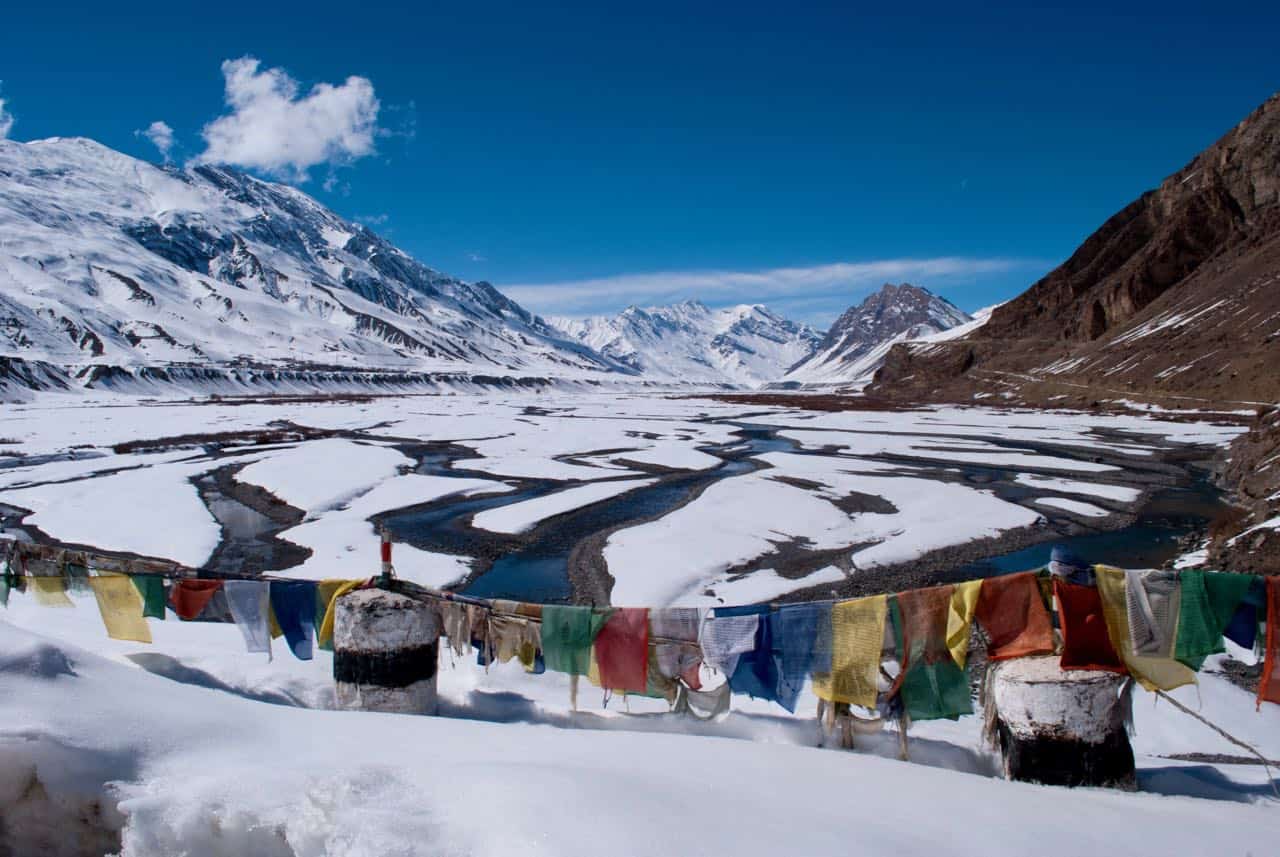
Spiti in Winters – Important Things to Know
You should know about these important things before you plan a Spiti Valley trip in winters. It will help you clear out certain expectations that if you are ready for a such a trip or not.
Temperature & Cold Conditions
As you are planning this trip in winters to Spiti Valley, you must remember that it is called cold dessert for a reason. The temperatures in February in Spiti Valley will be mostly subzero and negative up to -10 or -15 degrees Celsius. The wind chill will make it worse and may make Feels Like temperature to be above -20-degree Celsius.
Limited options to stay
The second worry factor when planning a trip to Spiti Valley in February or winter is here to stay. In winter, most of the hotels are closed in Spiti Valley. So, you will have to rely on traditional homestays and small open guest houses. There are a couple of hotels in Kaza that may operate, however, do not bank on the services.
Hence, it is advised that you carry your camping gear, including good rating sleeping bags and camps that can withstand in case of need. Sleeping bags are anyways handy when staying at homestays in winters as you may not like or used to the bedding provided by the hosts.
Limited options to eat
Much like places to stay at shut down in winters in Spiti Valley, the options for eating out are minimal. Fresh raw vegetables or fruits are also hard to buy even in Kaza town. Restaurants or makeshift dhabhas in Spiti Valley, as well as on the way, will be closed in February.
As homestay will be available during this time of the year in Spiti Valley, you will be able to eat basic food cooked at the homestay. Kaza’s main market may have a few local eating joints open. You should always pack the food from the homestay for lunch when going on day excursions from Kaza or one destination to another.
It is always better that you carry some packed food with you especially when you are self-driving and have the space to carry them.
Clothes to Carry & What to Pack
The next worry factor is what clothes to pack for the Spiti Valley winter trip. As in February, there will be winter conditions in Spiti Valley; it is crucial to carry layers of heavy woolen clothing so that you can adjust to the cold temperature accordingly.
It is absolutely necessary to carry heavy woolens for a Spiti valley trip in February and below is a list of some must-have items to pack when planning such a trip.
- heavy woolen jacket or parka (windproof),
- balaclava or monkey cap,
- inner thermals,
- fleece jacket,
- heavy woolen clothing,
- woolen socks,
- warm insulated shoes or trekking boots,
- warm hand gloves and,
- sunglasses
You must also refer to this list of things to pack for Spiti Valley trip.
Water difficulties & Dry pit toilets
Please note that due to cold conditions in Spiti Valley in February, the water is frozen everywhere in Spiti. There will not be any running water in pipes and hence, no running water in the toilets.
You will have to use dry pit toilets as there will be no water. This lack of water also means that you will not be taking a bath unless you want to freeze yourself. Some generous hosts may provide you with hot water in buckets.
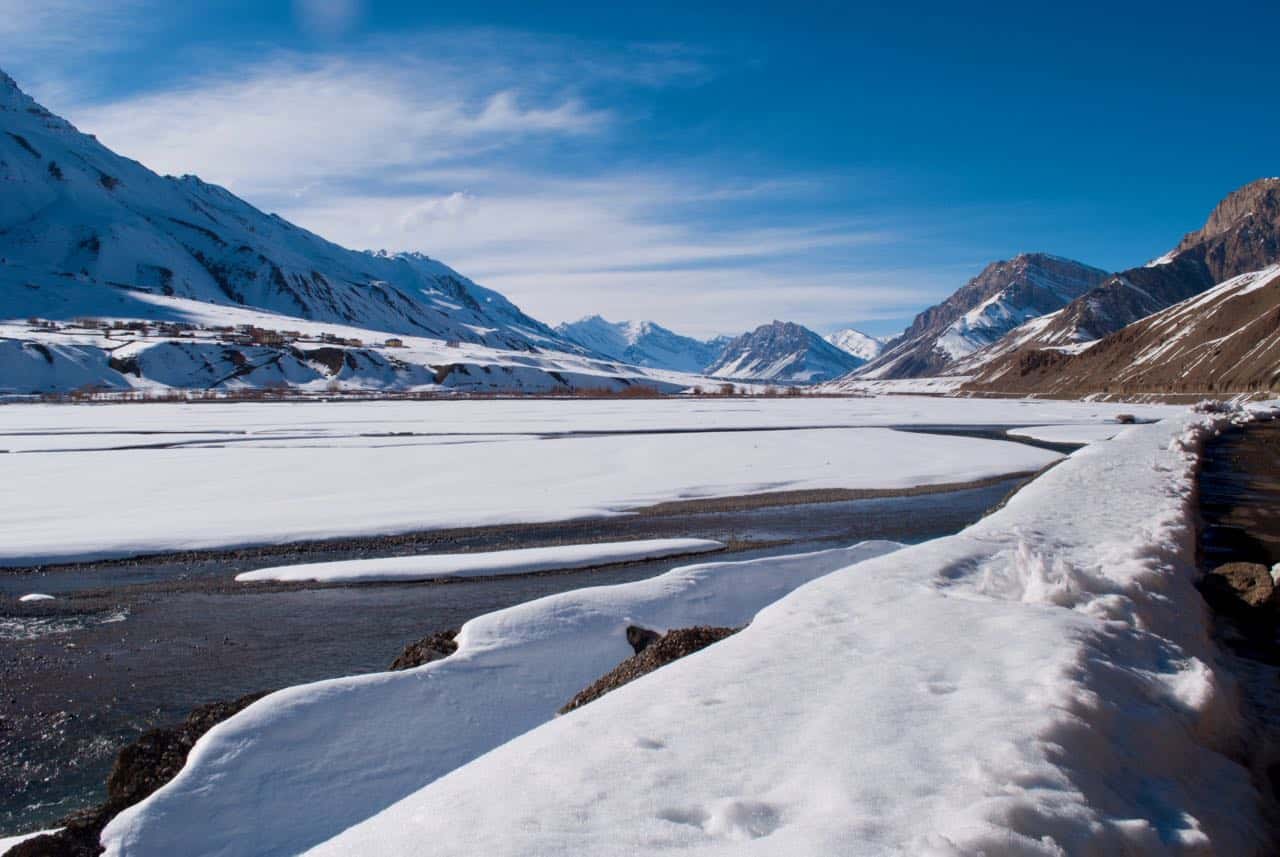
Roadblocks could be common
You must plan a trip to Spiti Valley in winter months with few buffer days in hand. The roads from Shimla to Kinnaur to Kaza might also close at several places due to heavy snowfall. Sometimes the roads might get closed for more than a week or even a month as happened a few years back.
Hence, that means you should not have anything critical back home to take care of in case such a road blockage happens. A road blockage of a couple of days is pretty common on a trip to Spiti Valley in winter months like February.
Snowfall could be common in winters
You should expect snowfall in Spiti Valley in February as well as on the way when you travel from Kinnaur Valley towards Spiti. Starting January, Spiti Valley starts to receive snowfall, and it becomes common in February and March especially.
Hence, you should plan your trip with this thing in mind that you might either get stuck in snowfall or have to return in between back home due to snowfall.
Roads within Spiti are closed
Some of the roads to high villages like Langza, Hikkim, or Komic will be closed in February in Spiti. Similarly, the road from Kaza to Kunzum Pass maybe just open till Moorang village, and you will not be able to reach beyond it.
On the Southside of Spiti towards Tabo, the road to Pin Valley is closed in winters as well as Mane villages and Demul, Lhlaung villages will be out of reach.
Snow & Ice on roads
Due to freezing conditions in Spiti in February, the roads do have snow or black ice especially around Nako and ahead of Schichiling village. So, make sure you are very cautious and careful when driving or riding on such roads.
Malling Nalla will be frozen, and vehicles do skid around it due to black ice. It is always better to start the day as the sun comes out so that you face less ice on roads. One small mistake can be fatal on such a trip or may get you stuck in the middle of nowhere without any help nearby.

Manali – Kaza will be closed, so no Spiti circuit trip
As the road from Manali to Kaza will be closed due to heavy snow presence at Kunzum Pass and Rohtang Pass, you will not be able to make a complete Spiti circuit in February. The road from Manali to Kaza remains closed in the winter months from November to May.
Hence, you will have to plan a trip from Shimla side to Spiti Valley and return from Shimla – Kinnaur side as well.
Lakes are frozen or unreachable
The lakes in Spiti Valley like Chandratal, Dhangkar Lake or Sopona Lake freeze in the months of winters. Also, especially in months of January to April / May, these high altitude lakes remain frozen.
Hence, it is better to keep them out of your winter Spiti trip plans.
Handful of Tourists
Making a winter trip to Spiti Valley is not everybody’s cup of team. Very few tourists visit places like Spiti Valley in February. Only those who are OK with such harsh and cold conditions brave the adventure of such trips. It may look as magical sitting here, but I bet you that the conditions are challenging up there in the high Himalayas.
The best part of having a handful of tourists around that you get to spend a good time at scenic spots with least disturbance, you enjoy with locals, and you stay with them. You can experience and capture the authentic life of Spiti.
Budget and Carrying Cash
If you are looking for shared transport to make a budget trip to Spiti Valley in February, do not rely on tourists’ presence. You may have to rent personal taxis during winters in Spiti Valley. So, plan your budget accordingly.
ATM in Kaza might not be functional. Hence, you must carry enough cash with you on the Spiti trip to pay your bills.
As you will be staying in homestays and eating basic food, the budget for the winter Spiti trip will be in control. So, you can expect about Rs 800-1000 per day per person in Spiti Valley for stay and food.
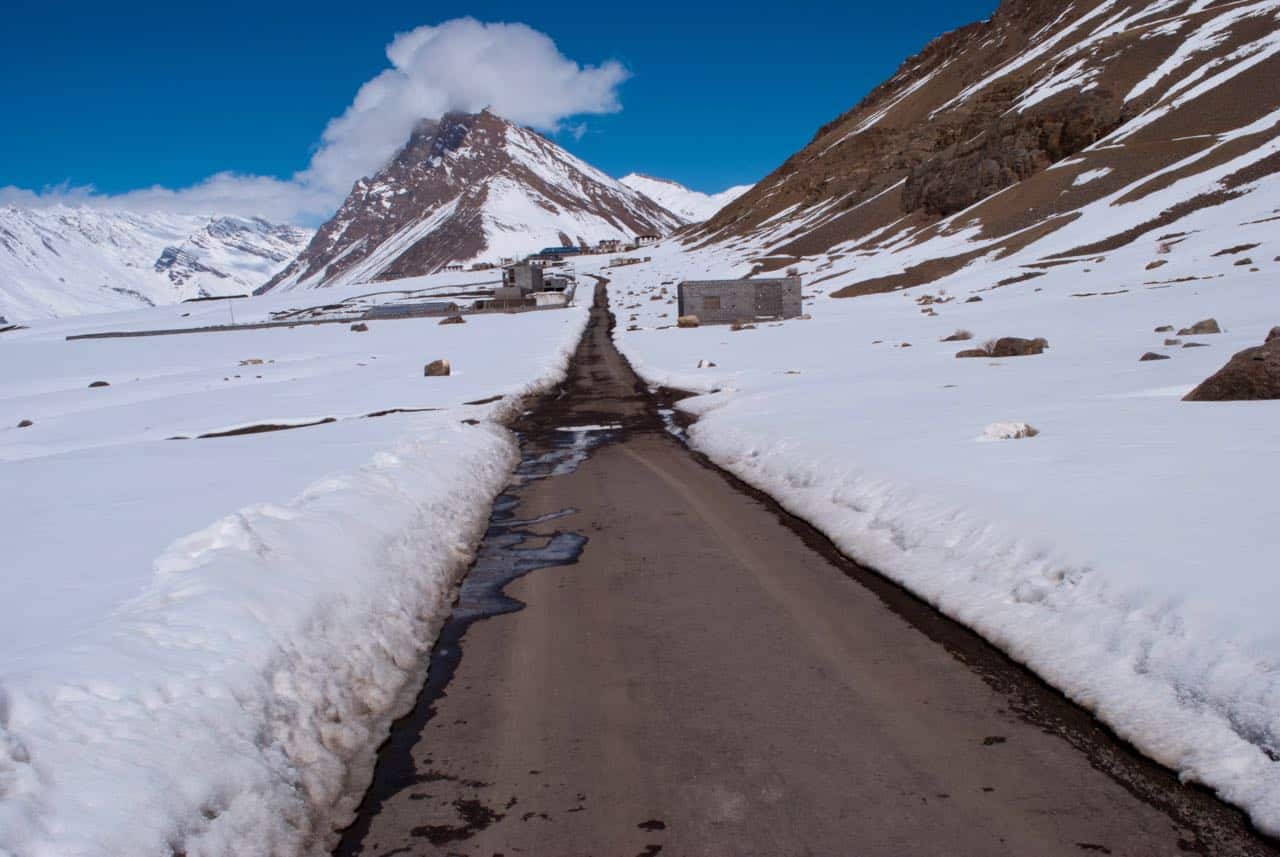
Public Transport
Public transport will be available from Shimla to Reckong Peo, Reckong Peo to Kaza and Kaza to Kibber if the roads are clear. Sometimes the roads are blocked but the buses from Reckong Peo to Kaza and return do run every morning. Within Spiti Valley as well some buses and shared local jeeps will be running for local commute.
You must be wondering why the buses run when the roads are blocked with snowfall??
Well, what happens is that buses start from Reckong Peo or Kaza and if the roadblock is not that major that blocks a long distance section, both buses will come to respective blocked ends and exchange passengers. The passengers will get down at each end, then walk to the other end.
Of course, you cannot walk 50 KMs in a day. So, in such situations, it is important to know where the blockage is and if you will be able to walk to the other end or not. So, you may need more days when planning a trip to Spiti Valley by public transport.
The bus from Kaza to Key – Kibber villages does run if the roads are clear of snow.
Difficulties with Cars & Bikes
Due to icy conditions in Spiti valley in February, your vehicles will not perform optimally. The diesel in the supply pipes and even in the tanks may / will freeze. You may carry antifreeze liquids for your windshield water but not always it helps based on its quality.
Never use the water at the windshield as it will freeze on it immediately due to subzero temperatures. Doing it will block the visibility and get you in trouble or stuck for long hours. You might be tempted to use hot water, but PLEASE DO NOT as it might crack the windshield.
As there will not be any mechanic easily available, the best is to make sure you have basic knowledge of repairs.
Fuel or Petrol availability in Kaza might be limited at times in winters. It may delay your trip by a day or two. So, as soon as the operator at the petrol pump opens the pump, tank up your vehicle. Otherwise, if you want to be on the safe side, it is best to carry the spare fuel with you on a winter trip to Spiti Valley in February.
Sunburn & Frostbites
You can experience sunburn and frostbite on the same day in Spiti Valley in winter. Always carry good hiking or trekking boots that keep your feet warm with woolen socks. Avoid getting your feet in touch in water as it will lead to frostbite.
Do not forget to carry sunglasses to avoid snow glare and make sure you apply high SPF sunscreen before going out in the sun with snow. It is not a good combination and believes me when I say; it can burn the skin, read burn. By any chance, if your skin is sensitive, it will not be good for many days to come. So, better go prepared than feeling sorry.
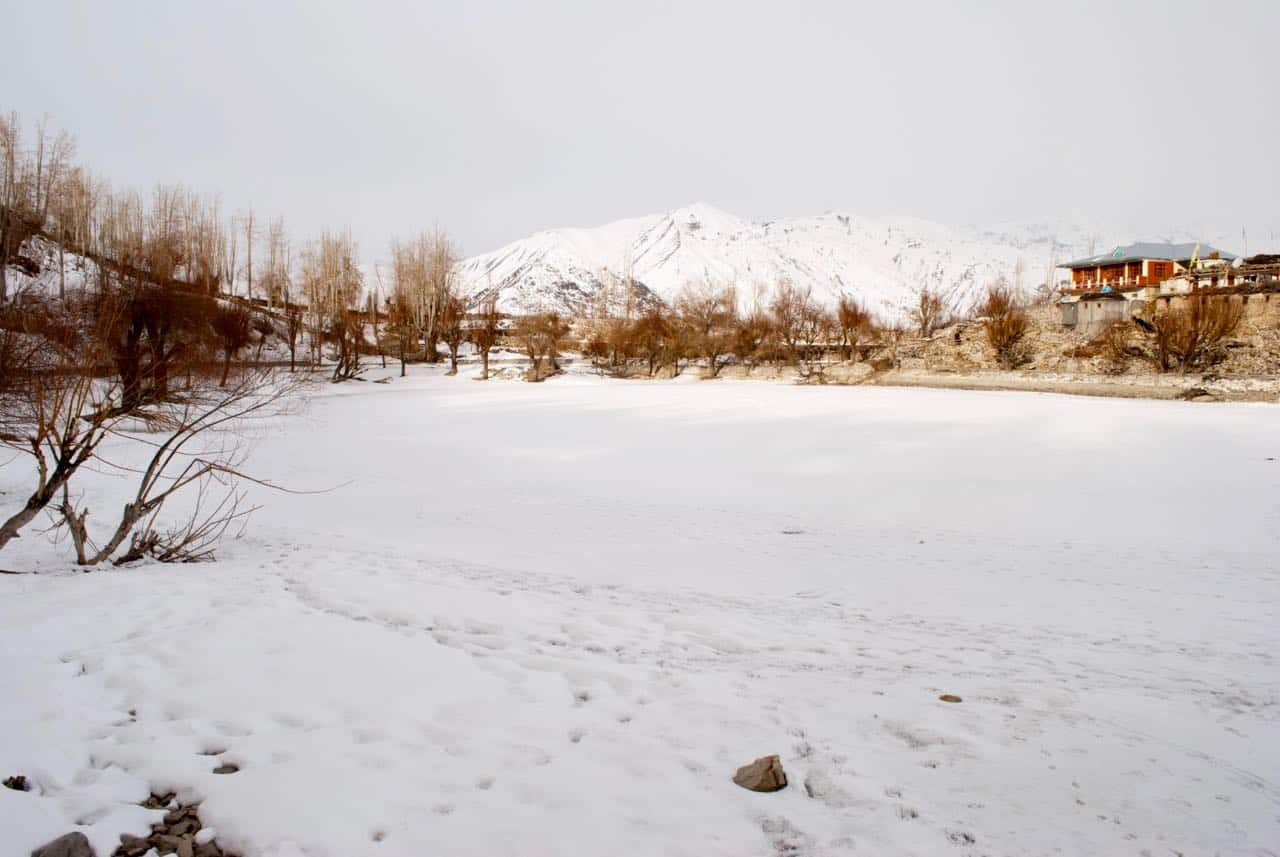
Skiing & Ice Skating is possible
Those who are interested in Skiing or Ice skating, you may give it a try in Spiti Valley during the winter months of February. Locals from ice rinks to have fun and as a pass time. Many locals have also started to learn ski up there, and you can travel with them to have some fun.
Snow Leopards and other wildlife of Spiti Valley
February is the time when you can plan a trip to Spiti Valley for wildlife spotting, especially the elusive big cat called the Snow Leopard !! Other wildlife you can also spot in winters in Spiti Valley. You just need the courage and heart to make such a trip.
If you really understand the above challenges and are still interested to spot a snow leopard in Spiti Valley coming winters, well give me a shout out on my Instagram account in a DM and I will connect you with the very best in such tours.
Snowy views with deserted trees
Lastly, the breathtaking snowy vistas of Spiti in February will blow your mind and heart away. All the pain and suffering of harsh cold conditions and treacherous drives will go away with its first sight.
The vast expanse of landscapes, boundless snow buried vistas will not let you settle without joy and excitement. You will keep wishing to stay there forever, but dreams do come to an end.
9 Day Itinerary for Spiti Valley in February
It is not like that every month the itinerary for Spiti Valley will be different in a year. However, when making a trip to Spiti Valley in winters, you may take care of certain points. I have highlighted some special tips in the below itinerary for Spiti Valley trip in February.
Day 1 – Delhi – Shimla/Narkanda
This day you can leave Delhi in the morning when fog goes away and either reach Shimla or Narkanda. It is better to reach Narkanda to cut short the journey for the next day.
On the other hand, Shimla is more urban while Narkanda is more peaceful and may have snow lying around. So, you can expect Narkanda to be a bit colder than Shimla with snow around. The options of stay at Shimla are abundance but Narkanda also has a decent number of options to stay.
The road to Spiti Valley in February might be closed around Narkanda only in case of heavy snowfall.
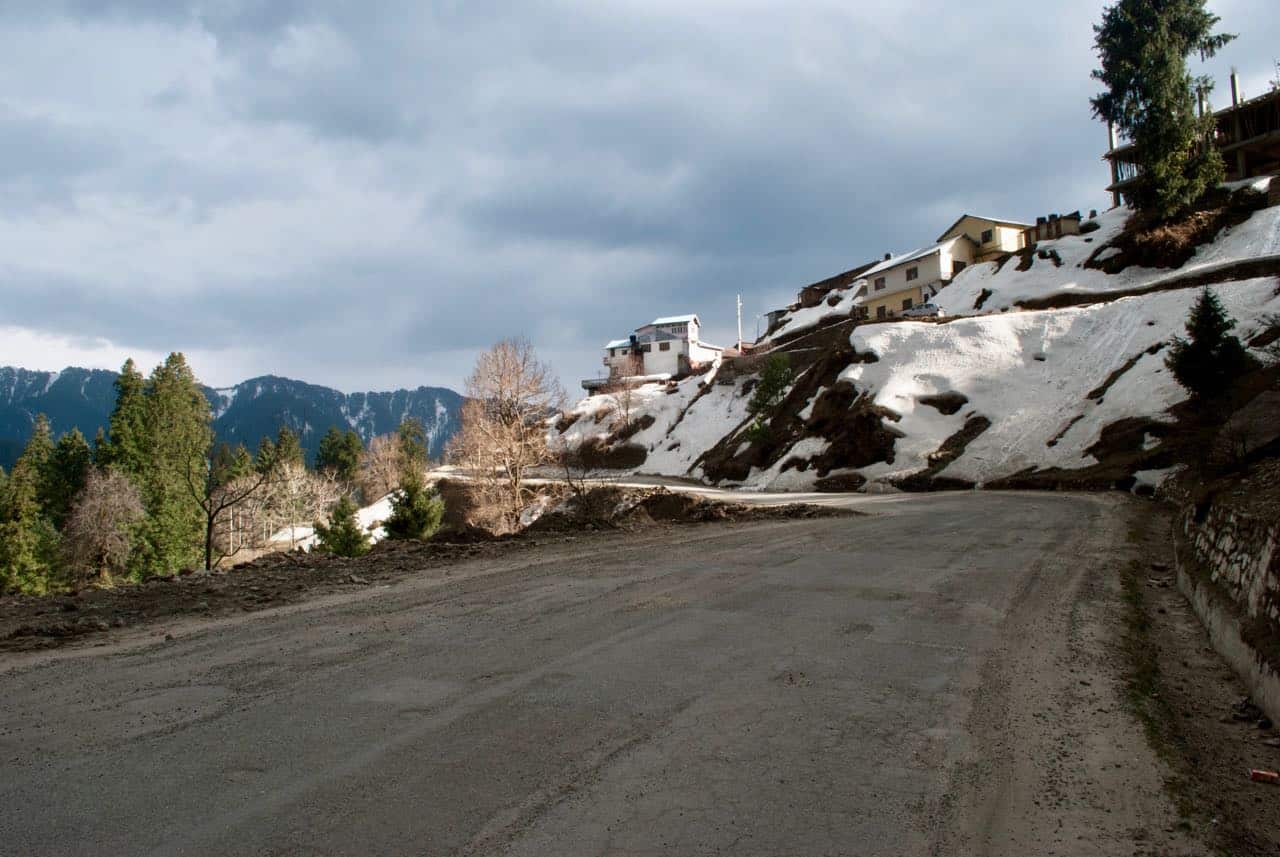
Day 2 – Narkanda – Rampur – Recong Peo – Kalpa
The next day you move from Narkanda or Shimla towards Kinnaur Valley. It will take about 6-7 hrs to reach Kalpa from Narkanda and about 8-9 hrs from Shimla. You can have an early lunch at Rampur before you enter Kinnaur Valley.
Kalpa being one of the most beautiful villages in Himachal makes an obvious night halt. As it will be wintering in February, the views of Kinner Kailash range from Kalpa will be amazing. The road might be closed to Kalpa in February, so you have to stay at Reckong Peo.
You should start early enough from Narkanda or Shimla to arrive at Kalpa well in time because most hotels will be closed in February. Hence, you will need some daylight to search for a decent guest house or hotel in Kalpa. You may also opt to stay at Reckong Peo as well. This place is another place where the road might be closed further to Spiti Valley in February.
Day 3 – Kalpa – Nako – Tabo
Nako will make a good spot for a lunch break. If conditions are favorable, you may find frozen Nako lake. Night stay at Tabo will be advisable to visit Dhankar Monastery the next day before you head towards Kaza.
This day you travel to Tabo, which will take about 8-9 Hrs to reach from Reckong Peo. You should be able to do lunch at Nako village and visit the frozen Nako lake when you are traveling to Spiti Valley in February.
Malling Nalla just ahead of Nako will be frozen, so do not forget to take a picture of it. You should drive with extra caution and care with snow/ice on the roads.
Finally, by evening, you will reach your first winter night stop in Spiti Valley, Tabo.
Day 4 – Tabo – Dhankar – Kaza
You can start from Tabo after having breakfast and visiting the oldest monastery in Tabo. On the way to Kaza, visit the Dhangkar Monastery. You will not be able to visit Dhangkar lake as due to the presence of snow, either the trek will be snowbound and in any case, the Dhangkar lake will be frozen.
The road to Pin Valley bifurcating from Atargoo will be blocked as Pin Valley gets cut off from the rest of the world in winters. So, skip it and reach Kaza. Do not forget to take some amazing pictures on this winter trip to Spiti in February between Kaza and Tabo.
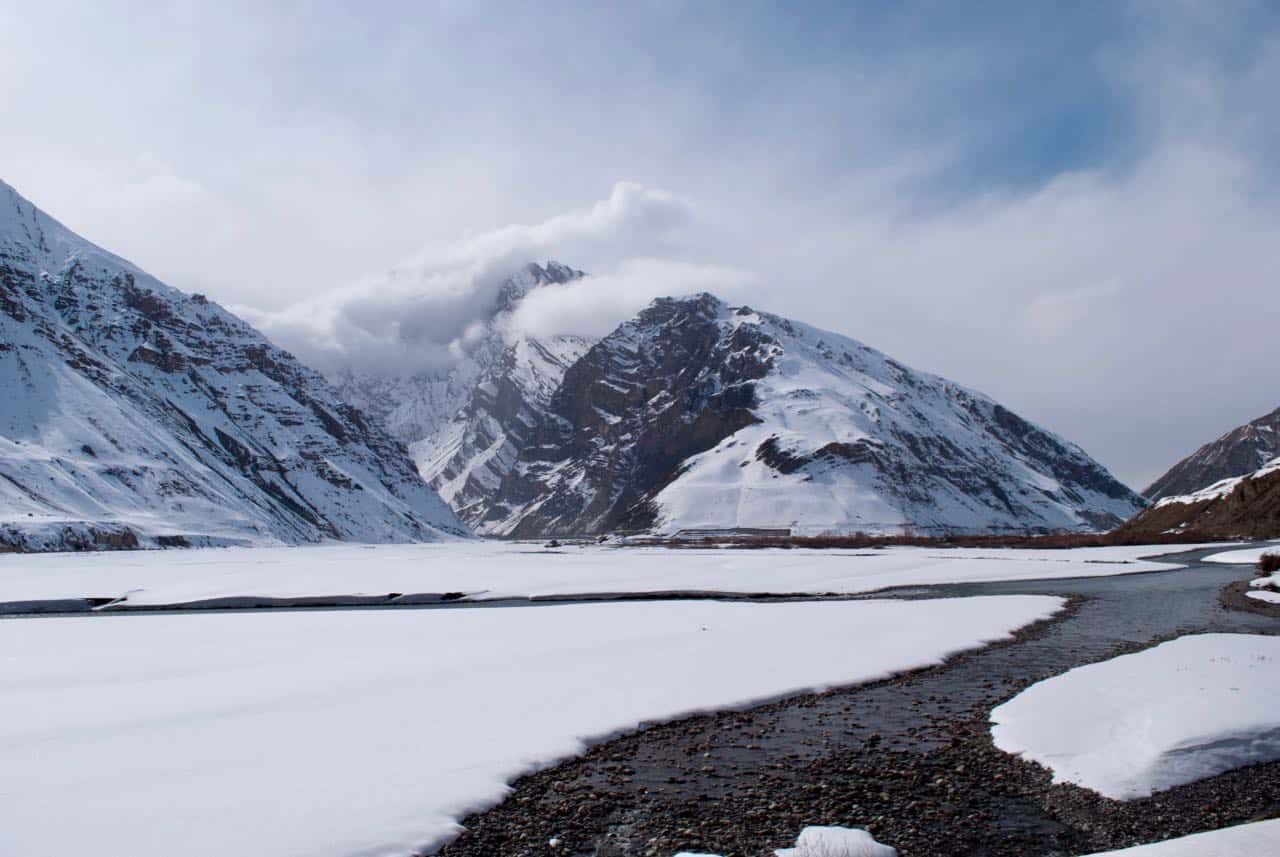
Day 5 – Kaza – Key – Kibber – Kaza
On Day 5, you can visit Key Kibber villages. You will not be driving more than a couple of hrs overall in the day. Explore these high villages along with the recently opened highest bridge in Asia connecting Chichcham village to Kibber village.
The frozen views of the valley from Key Monastery vantage point will be worth the pain you might have gone through over the last few days to reach Spiti Valley. It just blew me away at first sight when I did my first winter trip to Spiti Valley in March. But, I am sure Spiti in February will be equally interesting.
Day 6 – Kaza – Langza – Komic – Hikkim
This will be another day to hang out around Kaza. Mostly the roads to Langza – Komic – Hikkim are closed in winter months. So, that is one downside of visiting Spiti Valley in February or Spiti in winter. However, if you are feeling good, you might drive to the most nearby road head to Langza and then attempt to trek to the Langza and Komic villages.
PLEASE do not attempt to plan this trek alone in winters because, with snow, you may get lost. Always take a local with you.
If the roads to Langza – Komic – Hikkim is not open, you can travel towards the Kunzum Pass route, almost up to Moorang the road might be open. Again as you pass through Rangrik village the snowbound views of Spiti Valley in winters are majestic !!
Day 7 – Kaza – Tabo – Kalpa / Sangla
As we discussed in the article when making a trip to Spiti Valley in winters, you cannot do the entire circuit from Kinnaur to Spiti to Manali. The road from Kaza to Manali over Kunzum Pass will be closed in February.
So, now is the time to wrap up this snow-filled trip to Spiti Valley and start heading back home from Kinnaur Valley. You can either choose to stay at Kalpa or Reckong Peo at the same place where you stayed while coming over to Spiti. Or, you can go over to Sangla Valley this time to stay up there for a change.
The road to Chitkul will be closed in February, so that should not be on your plan 🙂 … Spend some time in Sangla Valley, few guest houses and hotels may be open in February in Kinnaur Valley.
Day 8 – Kalpa or Sangla – Narkanda
You can plan a late start from Sangla and after breakfast go over to Narkanda for the night stay. If you want to cut short the journey to home the next day, you can move to Fagu or Shimla to get used to concrete jungle 🙂
Day 9 – Narkanda to Delhi
Finally, this amazing adventure of Spiti Valley in February is going to end on this day. You can take an easy drive back home to the mortal world. It will take some time to get used to it and come out of the trance from the wonderland.
The snow views of winter Spiti Valley trip will disturb you for a while but yeah cherish them till you make another trip to Spiti Valley in winters.
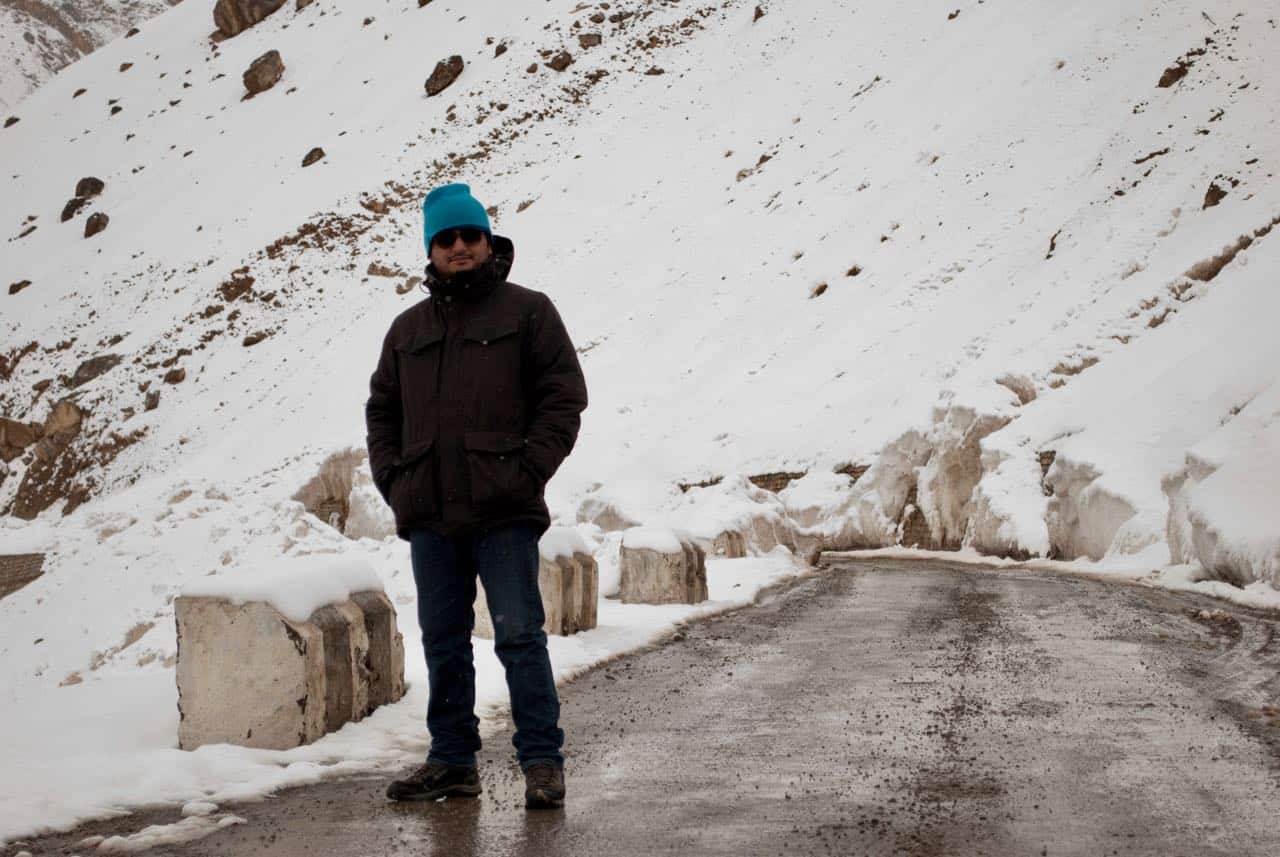
Conclusion
A trip to Spiti Valley in February is certainly one of the most adventurous journeys that you will ever take to the Himalayas. However, as this article explains, you should not get inspired by the Instagram pictures. Leaving without planning to such a desolate place in such cold conditions can be a messy affair.
Have a travel question?? You can subscribe to my YouTube channel and leave a comment to ask your travel questions about traveling to the Himalayas.
The trip to Spiti Valley in February requires sheer physical and mental strength and endurance to make such a trip. Knowledge never killed anyone hence you should be informed and well prepared to get the most out of your adventure trip to Spiti Valley.
Do not forget to follow me for all the latest updates on the weather and road conditions of Spiti Valley.
If you have any questions, please free to ask them in the comments section of the article. And in case one of your friends or family are traveling to Spiti Valley in February, do not forget to share this article with them. I will look forward to reading your adventures on the Spiti Valley winter trip in the comments.


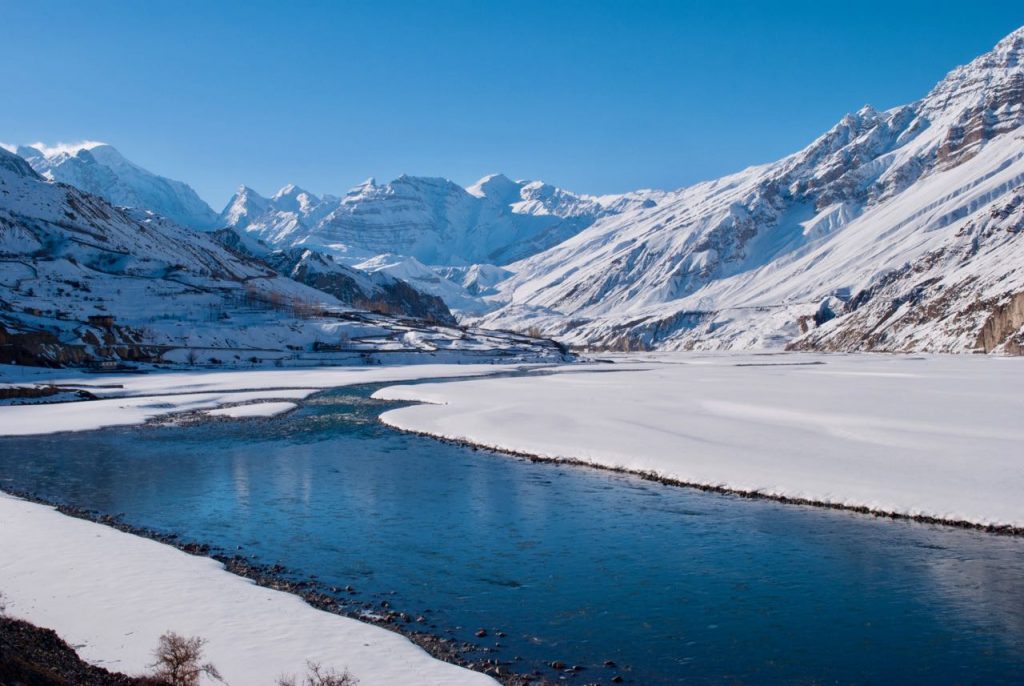




5 Comments
Comments section gets closed in 90 days. To ask your travel questions, you can follow my YouTube Channel for a faster reply or for a much slower reply follow me on Instagram. :)
Hi, I am planning a trip to Spiti in Feb and wanted to run my plan with you. We are planning to take 2 vehicles.
Day 1 Delhi to Jeori
Day 2 Jeori to Tabo (visit Guess Mummy Temple)
Day 3 Tabo to Kaza (visit Dhankar and Mud)
Day 4 Kaza to Losar and back (visit Key, Kibber and Chicham)
Day 5 Kaza (if possible we cover Hikkim)
Day 6 Kaza to Rampur
Day 7 Rampur to Solan
Day 8 Solan to Delhi
Day 9 Buffer day
Please share your thoughts. Also what are the must items that we should carry relating to vehical, medicines and personal clothing and toiletries. I have previously done Leh – Turtuk – Shyok – Panong – Hanle – Tso Moriri in June so I have the basic list. Is there anything else that you feel we must carry.
What about snow chains and oxygen cans?
Is there any recommendation for accommodation enroute during Feb? Also, if possible, please share details about the snow leopard tour that you mentioned in your detailed blog.
Thanks in advance!
Hi Dheeraj
A very good article and just came on the time we required the most. (great minds think alike !!!)
we are group of friends 4-5 people, planning to visit Spiti in Winters in January.
Last year we visited Leh mostly based on your articles. we really appreciate the work you doing. It was a great help.
So now we are here again !!
1) Is month of January best to do a bike trip in Spiti in winters ?
2) In which month Spiti receives the most snowfall ?
3) We wanted to do a trek to spot snow leopards, can you help to send me details in email? (As i don’t have a Instagram account)
4) we are also okay with doing a bike trip in summer but this would be a completely different experience and really want to spot the leopards there. so that’s why we are doing this in winter season. We were searching a lot to get the best person who knows about this but then you article came and we were so happy.
Regards
Baldevsinh Chauhan
Hey Dheeraj, look forward to your reply soon !
Hi, really insight full on the details mentioned….was planning to visit Spiti in from 13th to 21st oct from Spiti side…plz guide me in terms of itinerary and precautions for the same.
I intend to travel from Shimla side and return from the same side, considering unpredictability of weather…
You have 9 days in hand, following options I can propose
Day 1 : Reach Manali by overnight volvo of and stay overnight at Solang Valley as preferred for acclimatization
Day 2 : Manali / Solang – Chandratal – Kaza
Day 3 : Kaza – Ki – Kibber -Getter – Tashigang – Kaza
Day 4 : Kaza – Langza – Komik – Hikkim – Kaza
Day 5 : Kaza – Pin Valley – Dhangkar – Tabo
Day 6 : Tabo – Geyu Mummy – Nako – Kalpa
Day 7 : Kalpa – Sangla / Chitkul
Day 8 : Sangla / Chitkul – Sarahan – Narkanda
Day 9 : Narkanda – Delhi
Day 1 | Delhi – Narkanda
Day 2 | Narkanda – Kalpa
Day 3 | Kalpa – Nako – Nako Lake – Geyu Mummy – Tabo
Day 4 | Tabo – Dhankar – Dhankar Lake – Pin Valley (Mudh Village) – Kaza
Day 5 | Kaza Local Sightseeing
best options at Kaza. Get in touch with Tsering at 09418208987, he is more than a friend to me. Will offer you best price. Both are run by him only. He has home stays too.
— Ki, Kibber, Gette, Tashigang in the second half of the day
Day 6 | Kaza Local Sightseeing (Hikkim, Komik)
— Hikkim, Komik, Langza circuit
Day 7 | Kaza – Kunzum Pass – Chandratal
Day 8 | Chandratal – Manali
Day 9 | Manali – Delhi